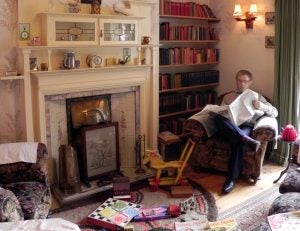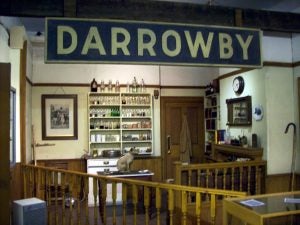Like many in the animal and veterinary fields, James Herriot and his endearing book series has touched my life. So, when PBS decided to debut its own take on the books with All Creatures Great & Small in 2020, my interest was again piqued.
Airing during a global shutdown, I think the series couldn’t have come at a more opportune time to rekindle the distinct spirit that Dr. Herriot imprinted on audiences all over the world.
As I don’t have any particular ties to veterinary medicine, this series didn’t quite ignite the career spark as it did for many of my peers. Ironically, I’m not even particularly interested in the British culture or history. However, I must say very few reads I’ve experienced gave me such euphoric “slice of life” feelings; whisking me away to another place and time I felt a craving for.

As much as I love innovation, I strongly believe we need to always look back and observe where we came from, embracing the best parts of it and learning from the worst. Herriot’s work has helped me to understand that. I feel I owe it to his legacy to perhaps share exactly why his collection of tales from a country veterinarian have done and meant so much.
The man, the vet, the legend
Don’t get disappointed when you hear this, but first you need to know there was no James Herriot or Darrowby, Yorkshire.
Well, there was a James Herriot — but he was a Scottish footballer who provided his namesake as a pseudonym to a veterinarian named James Alfred “Alf” Wight.
Wight was a 1939 graduate of Glasgow Veterinary College who, in July 1940, took a job with a rural practice nestled in the heart of Thirsk, Yorkshire. The rest would be both literary and veterinary history.
This could have easily been just another veterinary career lost to the sands of time. But the energetic Wight happened to be ambitious enough to pursue the idea of writing a book.
» Related: So, you want to go to vet school? Here’s how to approach it
Prompted by his wife, he finally put his pen to the paper and documented his career experiences in If Only They Could Talk (followed by It Shouldn’t Happen To A Vet) which was published in the UK in 1970.
A few short years later, St. Martin’s Press in New York combined both books and published All Creatures Great and Small in the states and beyond. A massive success, three sequels would follow in the years to come — not including other incarnations of TV series, feature films, and children’s adaptations.
So why the pseudonym? At the time the first book debuted, Wight was still a practicing veterinarian, so to keep things kosher and not inadvertently advertise his services, he chose to go with the pen name. Thirsk became the renowned “Darrowby,” named after the town’s real-life pub “The Darrowby Inn.”
An instant impact
With the runaway success this series became, the name James Herriot has found an unlikely home among the veterinary, animal agriculture, contemporary literature, and mainstream public factions all at once.
I think this one Redditor explains the common person’s love of these books perfectly in a post written during last year’s pandemic:
“I’ve been cleaning here at home for a while, and I came across my old copy of All Creatures Great and Small. I loved that book long ago, but during this crisis, it’s hit a new level of amazing for me. It helps me get out of my current situation into a simpler time in a landscape that was so gentle. It’s just a great escape for me. I’m not bingeing it, either. Just a few chapters a night and I’m set. It has been a long time since I got this level of comfort from a book. I simply feel safe reading it. Of course, the only problem now is that I want to become a veterinarian.”
Besides being an evidently gifted writer with charm, wit, realism with a healthy dash of creativity, I think something Herriot provided was the beatification of his everyday life doing what he so loved, even if that every day was many years ago.
Folks from all over the world were simply swept away by this country vet and found refuge in the colorful characters and landscapes. With today’s fast-paced modern landscape sometimes appearing so artificial and mundane, the life described by Wight seems worlds away.
What can we learn today?
These sentiments are certainly not unique. Today, Wight’s first home in “Darrowby” (known as the Skeldale house in the books) is an interactive museum attracting visitors from all over the world. It is known as the World of James Herriot, dubbing him as, rightly so, the most famous vet in the world.
I love this not only because it gives folks a genuine look into the nitty gritty of what animal agriculture really looks like, but also because, for agriculturalists anyway, it gives us a fond opportunity to appreciate where our forebearers came from.
What particularly fascinated me was reading how, even during the life of Wight, how much veterinary medicine drastically changed. For example, he notes a time where most medications were oral as opposed to injectable, or how things we take for granted like nitrile gloves and palpation sleeves were nonexistent.

Indeed, there is no sugar coating to some of the very harsh and dangerous hands-on tasks the poor 1940s and 1950s veterinarians had to undertake. No chutes, minimal sanitation, and a whole lot of elbow grease. The strained muscles, the near misses, the parturition nightmares and the horrifically chapped skins are painted in gripping realism.
Nonetheless, Wight’s son would go on to follow in his footsteps and take over the practice in a world he experienced changing before his own eyes. (Wight’s daughter would also go on to be a human doctor, in part due to his discouragement against the brute nature of the veterinary profession at the time.)
But this passing of the torch has extended far beyond his own family — I’m sure there are countless farm vets and agriculturalists of all sorts owing least a part of their career to the beloved “Dr. Herriot.”
This, I think, is a perfect reflection to the uniqueness of this man: His work stands as a testament not only to the days gone by, but also to how the agricultural everyman can touch the future.
Jaclyn Krymowski is a graduate of The Ohio State University with a major in animal industries and minor in agriculture communications. She is an enthusiastic “agvocate,” professional freelance writer, and blogs at the-herdbook.com.



